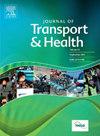Behavioral intentions towards ride-hailing services during the Pandemic: Using the health belief model and the moderating role of health norms and age
IF 3.3
3区 工程技术
Q2 PUBLIC, ENVIRONMENTAL & OCCUPATIONAL HEALTH
引用次数: 0
Abstract
Introduction
Health-related crises, such as the COVID-19 pandemic, affect travel behavior, especially when personal health is considered. Health Belief Model (HBM), a psychological framework that explains health-related behavior based on perceived risks, benefits, and triggers for action (called "cues to action"), is used in this study to understand individuals' decisions about using ride-hailing services during such crises.
Method
Data was collected via an online questionnaire from 413 respondents in Tehran over four months. Descriptive analysis, factor analysis, and structural equation modeling were employed to analyze the data.
Results
It has been shown that people are more likely to use ride-hailing if they consider it to be safer or more convenient than other modes, and if they are encouraged by social cues or previous positive experiences. The perception of costs and fear of infection can, however, discourage users. Moreover, two moderating variables—health norms and age—were incorporated into the analysis. Participants were classified into high and low health norm groups based on their adherence levels, and into two age cohorts: individuals aged over 31 and those aged 30 or younger. The results revealed that the moderating effects of health norms and age varied across different structural paths, indicating distinct interaction patterns within the model.
Conclusion
These findings suggest that promoting ride-hailing during future health crises requires both reducing perceived risks (e.g., by advertising safety protocols) and enhancing social incentives (e.g., showcasing positive user experiences).
大流行期间乘车服务的行为意向:使用健康信念模型以及健康规范和年龄的调节作用
与健康相关的危机,如COVID-19大流行,会影响旅行行为,特别是在考虑到个人健康时。健康信念模型(HBM)是一个心理学框架,它根据感知到的风险、利益和行动触发器(称为“行动线索”)来解释与健康相关的行为,本研究使用该模型来理解个人在此类危机期间使用网约车服务的决定。数据通过在线问卷从德黑兰的413名受访者中收集,历时4个月。采用描述性分析、因子分析和结构方程模型对数据进行分析。结果研究表明,如果人们认为网约车比其他方式更安全或更方便,并且受到社会暗示或之前的积极经历的鼓励,他们更有可能使用网约车。然而,对成本的认识和对感染的恐惧可能会阻碍使用者。此外,两个调节变量-健康规范和年龄被纳入分析。参与者根据他们的坚持程度分为高健康标准组和低健康标准组,并分为两个年龄组:31岁以上的人和30岁以下的人。结果表明,健康规范和年龄的调节作用在不同的结构路径上存在差异,表明模型中存在不同的相互作用模式。这些发现表明,在未来的健康危机中推广网约车既需要降低感知风险(例如,通过宣传安全协议),也需要增强社会激励(例如,展示积极的用户体验)。
本文章由计算机程序翻译,如有差异,请以英文原文为准。
求助全文
约1分钟内获得全文
求助全文

 求助内容:
求助内容: 应助结果提醒方式:
应助结果提醒方式:


